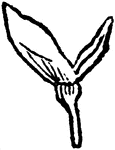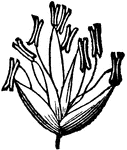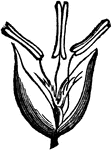
Meadow Spear Grass
Meadow Spear Grass (Glyceria nervata), also known as Nerved Manna Grass, has a broad, open panicle,…

Meadow Spear Grass
Meadow Spear Grass (Glyceria nervata), also known as Nerved Manna Grass, has a broad, open panicle,…
Oat
The common oat (Avena sativa) is a species of cereal grain grown for its seed. While oats are suitable…

Orchard Grass
Orchard Grass (Dactylis glomerata) also called Rough Cock's-foot, flowers in dense clusters. The stem…

Orchard Grass
Orchard Grass (Dactylis glomerata), also known as Rough Cock's-foot, flowers in dense clusters. The…
Perennial Rye Grass
The Perennial Rye Grass (Lolium perenne) has a smooth, erect stem growing from fifteen inches to two…

Perennial Rye Grass
The Perennial Rye Grass (Lolium perenne) has a smooth, erect stem growing from fifteen inches to two…

Quaking Grass
Quaking Grass (Briza media) has an erect panicle with very slender spreading branches. The spikelets…

Quaking Grass
Quaking Grass (Briza media) has an erect panicle with very slender spreading branches. The spikelets…
Red Fescue Grass
The leaves of the Red Fescue (Festuca rubra) are broadish and flat. The root is extremely creeping and…
Red Fescue Grass
The leaves of the Red Fescue (Festuca rubra) are broadish and flat. The root is extremely creeping and…
Redtop Grass
The Redtop Grass (Agrostis vulgaris), also known as Burden's Grass, is a perennial grass with smooth,…

Redtop Grass
The Redtop Grass (Agrostis vulgaris), also known as Burden's Grass, is a perennial grass with smooth,…
Reed Canary Grass
The Reed Canary Grass (Phalaris arundinacea) has a panicle that is slightly branched, clustered, and…

Reed Canary Grass
The Reed Canary Grass (Phalaris arundinacea) has a panicle that is slightly branched, clustered, and…
Rice
Rice (Oryza sativa) is a long panicled grass, having, when ripe, some resemblance to oats, the seed…

Rough-Stalked Meadow Grass
The Rough-Stalked Meadow Grass (Poa trivialis) has webbed florets and a five-ribbed outter palea. The…

Rough-Stalked Meadow Grass
The Rough-Stalked Meadow Grass (Poa trivialis) has webbed florets and a five-ribbed outter palea. The…
Rye
Rye (Secale cereale) is a grass grown extensively as a grain and forage crop. Rye is characterized by…
Sheep's Fescue Grass
Sheep's Fescue (Festuca duriuscula) is known by its narrow panicle. It has short, tufted, bristle-shaped…

Sheep's Fescue Grass
Sheep's Fescue (Festuca duriuscula) is known by its narrow panicle. It has short, tufted, bristle-shaped…

Slender Spiked Grass
The Slender Spiked Fescue (Festuca loliacea) is species nearly allied to the tall fescue, and possesses…

Slender Spiked Grass
The Slender Spiked Fescue (Festuca loliacea) is species nearly allied to the tall fescue, and possesses…

Sounthern Bent Grass
The Southern Bent Grass (Agrostis dispar) furnished rather course hay, and leads a large produce on…
Sounthern Bent Grass
The Southern Bent Grass (Agrostis dispar) furnished rather course hay, and leads a large produce on…
Sweet-scented Vernal Grass
Sweet-scented Vernal Grass (Anthoxanthum odoratum) has three-flowered spreading spikelets. The lateral…

Sweet-scented Vernal Grass
Sweet-scented Vernal Grass (Anthoxanthum odoratum) has three-flowered spreading spikelets. The lateral…

Sweet-scented Vernal Grass
Sweet-scented Vernal Grass (Anthoxanthum odoratum) has three-flowered spreading spikelets. The lateral…
Tall Fescue Grass
Tall Fescue Grass (Festuca elatior) is found commonly in moist meadows. The panicle is contracted, erect,…
Tall Fescue Grass
Tall Fescue Grass (Festuca elatior) is found commonly in moist meadows. The panicle is contracted, erect,…

Tall Meadow Oat Grass
Tall Meadow Oat Grass (Arrhenatherum avenaceum), or Tall Oat Grass is the avena elatior of Linnaeus.…
Tall Meadow Oat Grass
Tall Meadow Oat Grass (Arrhenatherum avenaceum), or Tall Oat Grass is the avena elatior of Linnaeus.…
Timothy Grass
Timothy is commonly grown for cattle feed and, in particular, as hay for horses. It is relatively high…

Timothy Grass
Timothy (Phleum pratense), or Herd's Grass is commonly grown for cattle feed and, in particular, as…
Two-rowed Barley
The Two-rowed Barley's spike, or ear, is long and somewhat compressed, and the grain is of a very good…

Water Hair Grass
Water Hair Grass (Aira aquatica) is the sweetest of the British grasses. Its stems and leaves when green…

Water Spear Grass
Water Spear grass (Glyceria aquatica), also known as Reed Meadow grass, grows in wet soils and the shallow…
Water Spear Grass
Water Spear grass (Glyceria aquatica), also known as Reed Meadow grass, grows in wet soils and the shallow…
Wheat
Egyptian wheat (Sorghum bicolor) has long slender stalks growing seven to ten feet. It matures late…
Wheat
St. Peter's corn (Triticum monococcum) is a one-seeded wheat with a high portein content. This picture…
Wheat
Wheat (Triticum vulgare) is an annual herbaceous plant. The seed is oblong, or a compressed oval, surrounded…
Wheat
Wheat (Triticum vulgare) is an annual herbaceous plant. The seed is oblong, or a compressed oval, surrounded…
Wheat
Wheat (Triticum spelta) is an annual herbaceous plant. The seed is oblong, or a compressed oval, surrounded…
Wheat
Wheat (Triticum spelta) is an annual herbaceous plant. The seed is oblong, or a compressed oval, surrounded…
Wild Oat Grass
Wild Oat Grass (Danthonia spicata), also referred to as White Top grass, and Old Fog grass, is common…

Wild Oat Grass
Wild Oat Grass (Danthonia spicata), also referred to as White Top grass, and Old Fog grass, is common…

Wild Oat Grass
Wild Oat Grass (Danthonia spicata), also referred to as White Top grass, and Old Fog grass, is common…

Wild Oat Grass
Wild Oat Grass (Danthonia spicata), also referred to as White Top grass, and Old Fog grass, is common…
Wild Oat Grass
Wild Oat Grass (Danthonia spicata), also referred to as White Top grass, and Old Fog grass, is common…

Wood Hair Grass
Wood Hair grass (Aira flexuosa), also known as Common Hair grass, is a common grass found on dry and…

Wood Hair Grass
Wood Hair grass (Aira flexuosa), also known as Common Hair grass, is a common grass found on dry and…

Wood Meadow Grass
Wood Meadow Grass (Poa nemoralis) grows from eighteen inches to two feet high. It has a perennial, creeping…

Wood Meadow Grass
Wood Meadow Grass (Poa nemoralis) grows from eighteen inches to two feet high. It has a perennial, creeping…
Yellow Oat Grass
The Yellow Oat Grass (Avena flavescens) is a perennial grass siutable for dry meadows and pastures.…

Yellow Oat Grass
The Yellow Oat Grass (Avena flavescens) is a perennial grass siutable for dry meadows and pastures.…